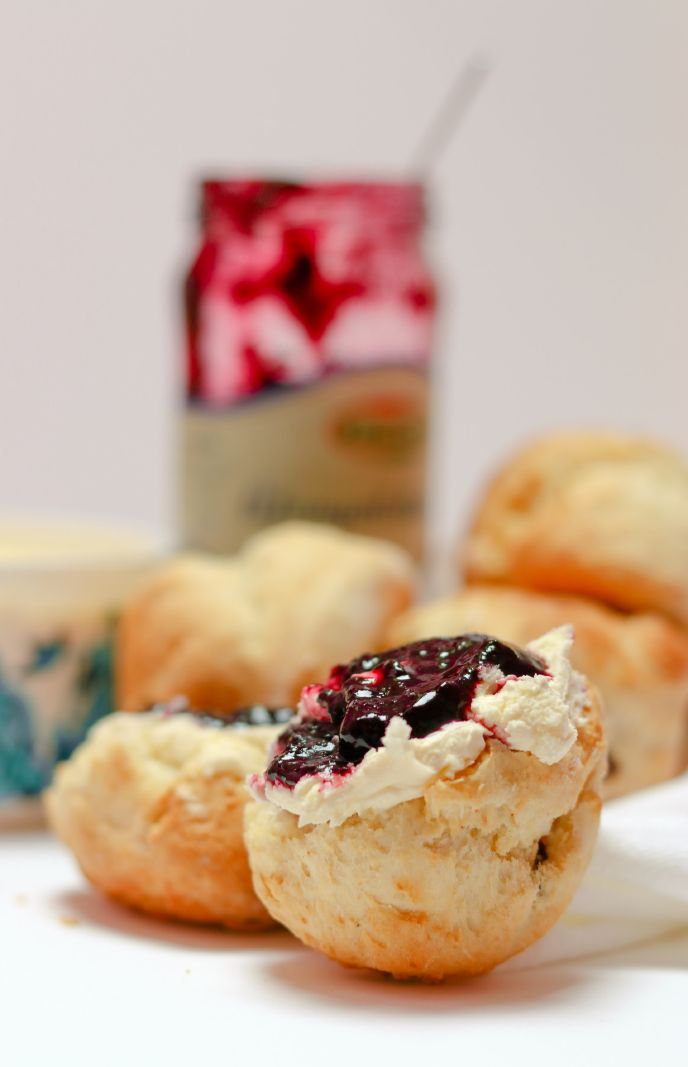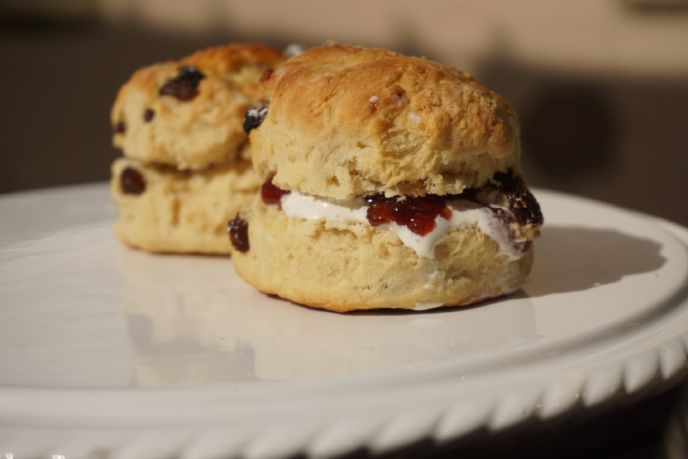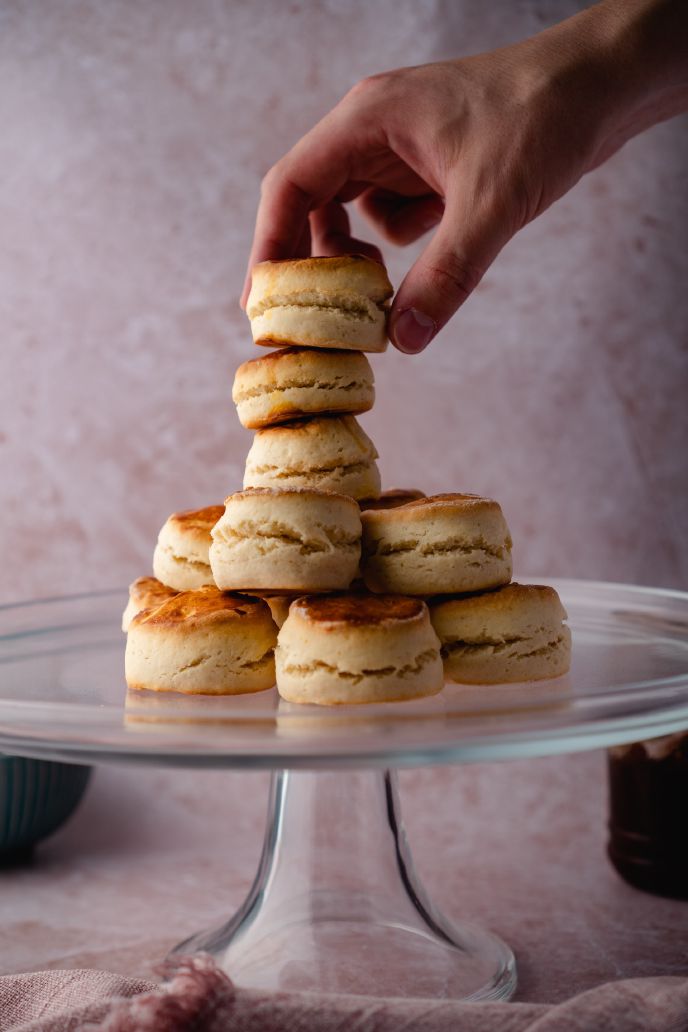In case you’re wondering, yes, these scones really are that good, and we Brits really do eat them…often.
But when it comes to fluffy scones recipes, there is a lot to choose from - and they’re not all created equal.
For me, a fluffy scones should have lots of fruit, be sweet, and be super, well, fluffy. As much as I like cheese scones, there’s nothing better than a warm fruit scone with jam and clotted cream!
They should be tall and filling, and you should just about be able to hold one half - loaded with cream and jam - without it breaking. Whether that’s whipped cream or clotted cream is up to you. Though I have a deep love for clotted cream!

What is the Secret to Making Fluffy Scones?
When it comes to a scone recipe, I like to keep it simple. Don’t go crazy adding in ingredients, and don’t work the dough too hard - that’s how you get flat and hard rock cakes.
If it’s your first time making scones, I highly recommend using an English scones recipe. We invented them after all, so why would you look anywhere else?
I’m not saying you can’t find a good recipe anywhere else, but I firmly believe you’ll get a better result by looking across the pond.
And for me, bread flour is a must. Using cake flour or all-purpose just won’t give your scones the right amount of structure and they won’t rise the same.
Ingredients for Fruit Scones
I’ve been using this recipe for years, and I’ve made these by the hundreds.
When I worked in a bakery not too long ago, I would make a minimum of 50 per day. So when I say this recipe works, I promise you won’t be disappointed.
Bread Flour - I know you would think that using a cake or pastry flour would be better for a light crumb; bread flour is the key to getting a good rise that stands up even after they cool.
Margarine - this one might seem like an odd choice, but I have been using margarine in my scones since I was little. If it was good enough for my Nana, it’s good enough for me. You want it to be cold but not frozen.
Baking powder - if you want them to rise, you’re going to need a rising agent.
Sugar - white sugar is essential for this. Using brown will significantly change the texture.
Sultanas - because what’s a fruit scone without sultanas?
Whole milk - as always with baking, you want to be sure to use full-fat for maximum flavor and texture.

What are Sultanas?
You don’t often see sultanas in the States, which is a shame because I much prefer them to raisins. Both are made using dried grapes, but sultanas come from green grapes. They add sweetness and moisture to the scones.
If you can’t find sultanas, try golden raisins or regular in a pinch. I like to soak my raisins in hot tea before I use them in baking. This infuses amazing flavor and plumps them up, so they don’t pull any moisture from the cake.
Add hot water and a few tea bags to a bowl and let sit for about three to four minutes. Remove the tea bags and leave the raisins to cool in the liquid. Pour out any excess and store raisins in the fridge until ready to use.
Should Scones Have Eggs in the Recipe?
This is a tough one, and the answer is - it’s up to you. I’ve eaten with and without eggs, and both are great. Using eggs will enrich the dough, giving it extra decadence.
Plus, the eggs will act as a raising agent (so you’ll have to adjust the baking powder).
Personally, I like this recipe because it’s so easy to modify for vegans!
Easy Vegan Scone Recipe
The recipe is super quick to make dairy-free:
- Change out the margarine (which in many cases are already vegan) for a vegan butter alternative.
- Use your favorite dairy-free milk in place of whole milk. I would suggest soy milk as it’s closest in flavor and texture to cow’s milk.
See. Wasn’t that easy?! Though I’ve never tried to use gluten-free flour, I don’t see why it wouldn’t work with some of the great options we have these days.
Vegan Scones:
- 365 grams Bread Flour
- 20 grams Baking Powder
- 92 grams Vegan Butter Alternative
- 92 grams White Sugar
- 126 grams Sultanas
- 1.12 Litres (1,120 ml) Dairy-free Milk
Follow the recipe as it is laid out below. Use more of the dairy-free milk instead of egg wash.

How to Make Foolproof Scones
Why did my scones sink?
Why are my scones dry?
How do I know when my scones are ready?
All good questions! Making scones doesn’t need to be complicated, and after one or two good batches, you’ll be a pro!
But if you’re struggling, I’ve got some tips and tricks for making the best scones ever.
- Start with cold margarine so that it will form breadcrumbs in the flour mix.
- Keep an eye on the initial mix, and keep the mixer on low. You don’t want this to form a paste, so stop the mixer when you see crumbs.
- As you pour in the milk, keep the mixer on low and stop it as soon as the milk is all in.
- You will probably need all of the milk noted in this recipe, but keep an eye on the mix. It should be sticky and not pulling away from the sides.
- Let it rest! I can’t stress this enough - walk away for at least five minutes. This gives the magic time to work - the raising agent will start to work, and the gluten will relax.
- After a good five minutes (ten if you can wait), add in the fruit and mix to combine.
- At this point, I like to turn up my mixer for a quick burst of high-speed paddling to bring it together - just five seconds!
- Scrape everything out onto the counter and bring it together gently with your hands.
- DO NOT KNEAD THE DOUGH! If it looks shaggy, simply press into the sides.
- Rather than rolling this out, press down with your hands until it’s more or less the right depth. It doesn’t have to be perfect.
- Cut with a sharp cookie cutter - not a glass! Using a blunt cup or glass will press the dough down, causing a small seal at the bottom, rather than cutting through the dough and leaving exposed edges. You won’t see as good of a rise if you use a glass.
- Put your scones into a hot oven. If you go in early, you won’t get that rise.
- Test your scones are done by gently pressing on the top. It should press a little but will keep its shape.
- To test the middle, insert a sharp knife right into the center (coming in from the side, not the top). It should come out clean.
- When in doubt, pull them out. These will only need about 12 minutes in the oven, too long, and they will dry out. Remember, they’ll keep cooking on the tray even out of the hot oven!
The Ultimate Fluffy Scones Recipe
Ingredients:
- 365 grams Bread Flour
- 20 grams Baking Powder
- 92 grams Margarine
- 92 grams White Sugar
- 126 grams Sultanas
- 1.12 Litres (1,120 ml) Whole Milk
Method:
- Preheat oven to 180°C/350°F and line a baking sheet with parchment paper.
- Pour the flour into the bowl of a stand mixer with the baking powder, margarine, and sugar.
- Using the paddle, beat the mixture on low until it looks like bread crumbs.
- Slowly pour the milk into the mixer as it turns on low.
- Allow to mix for an extra 10 seconds once the milk is incorporated, and then turn off the mixer.
- Allow the mix to sit for five minutes.
- Add in the fruit and mix on second speed for about 10 seconds.
- Before you pull the dough, turn the mixer to medium speed and mix with the paddle for five seconds to bring it all together.
- Pour the mix out onto a floured surface, scraping the side as you work, and gently pat down to the desired thickness - don’t use a rolling pin; it will overwork the dough. Ideally, you want the dough to be a couple of inches thick.
- Cut your scones using a round cookie cutter and gently place them onto a baking tray. Don’t crowd the tray.
- Egg wash the tops and bake for 10-15 minutes or until golden brown.
